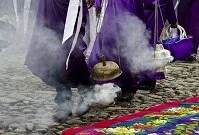Culture & Identity of Guatemala
Introduction

Good Friday
The people of Guatemala are quite diverse as the country is home to a large number of Native American Indians. However, there are also numerous people with mixed ancestry and some who are fully European. For many of these people, the way of life reflects their ethnicity, but also their location.
Guatemala is evenly divided with about half the population living in urban areas and about half in rural areas. For many of the people in more rural areas farming is their occupation. For many of these people life revolves around the sun, the weather, and the seasons. However, many of these people are also Native American Indians, which further contributes to their way of life and culture.
The lifestyle in the cities can be quite different. Most people have jobs in the services sector and urban life permeates the culture. For many people public transportation is their means of getting around, shops are closer, and more items are accessible. Among people with higher wages, most also live in the cities, meaning there are a great number of amenities in the cities available.